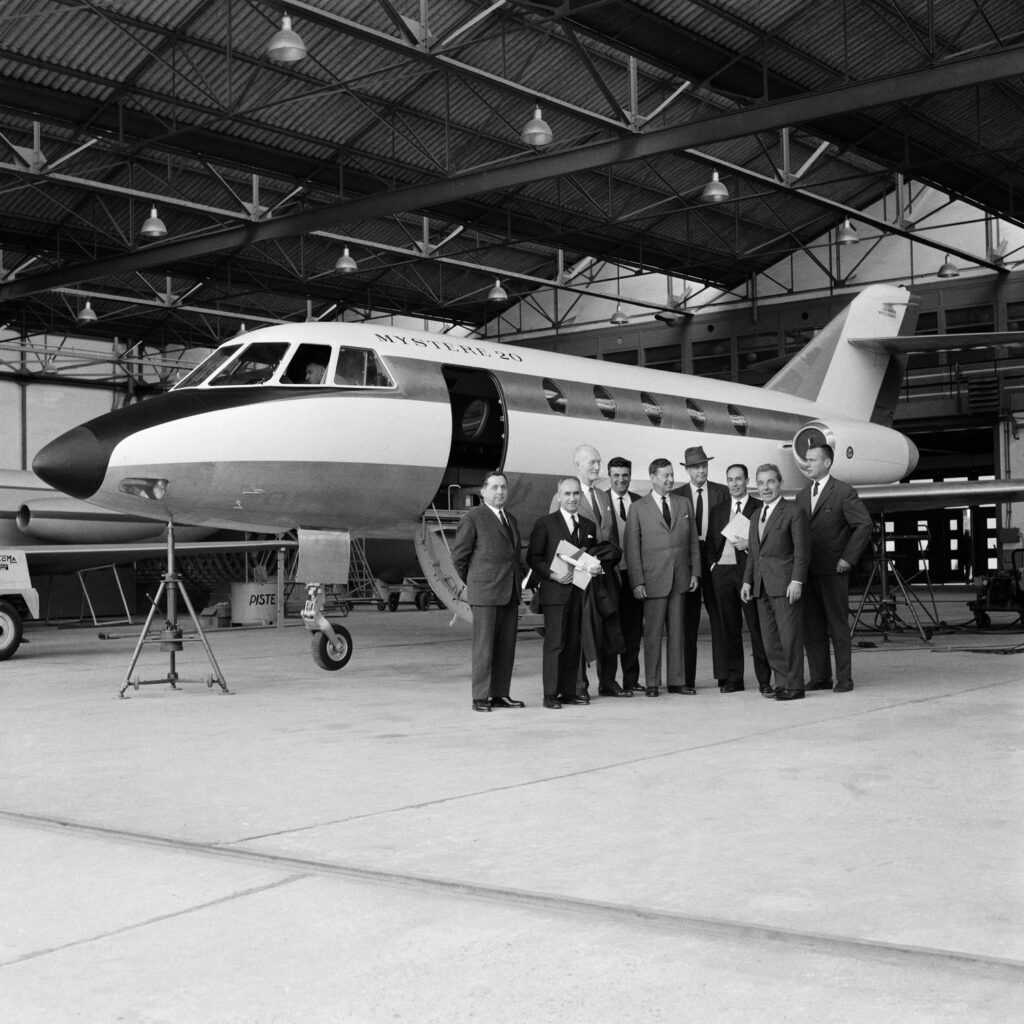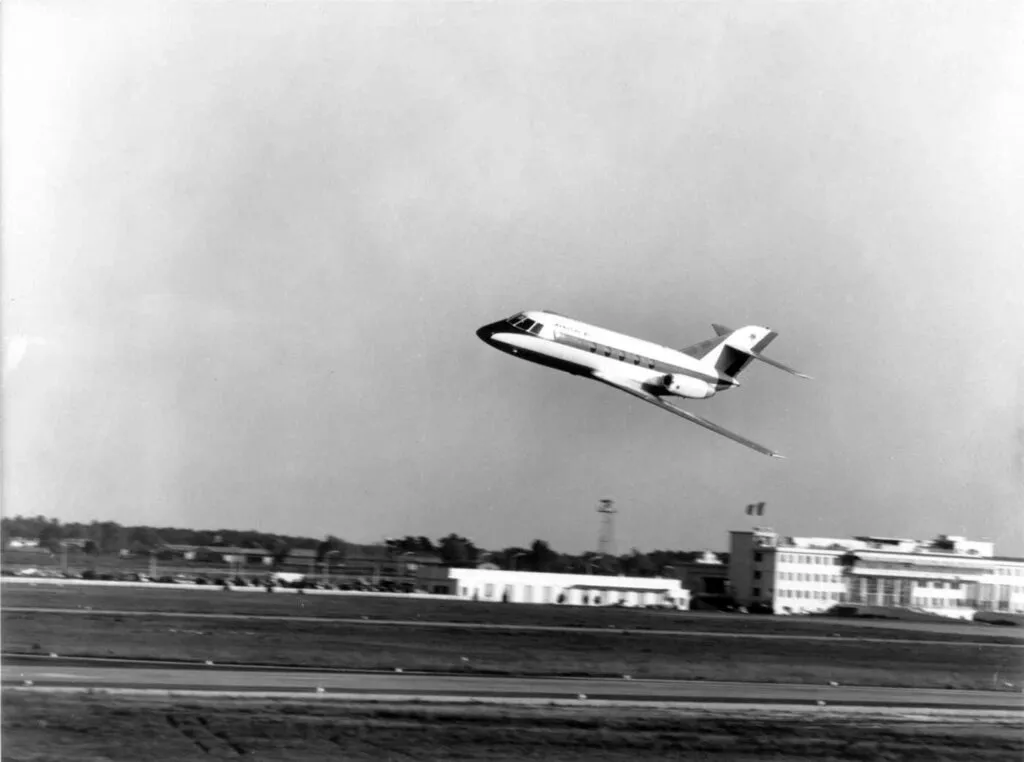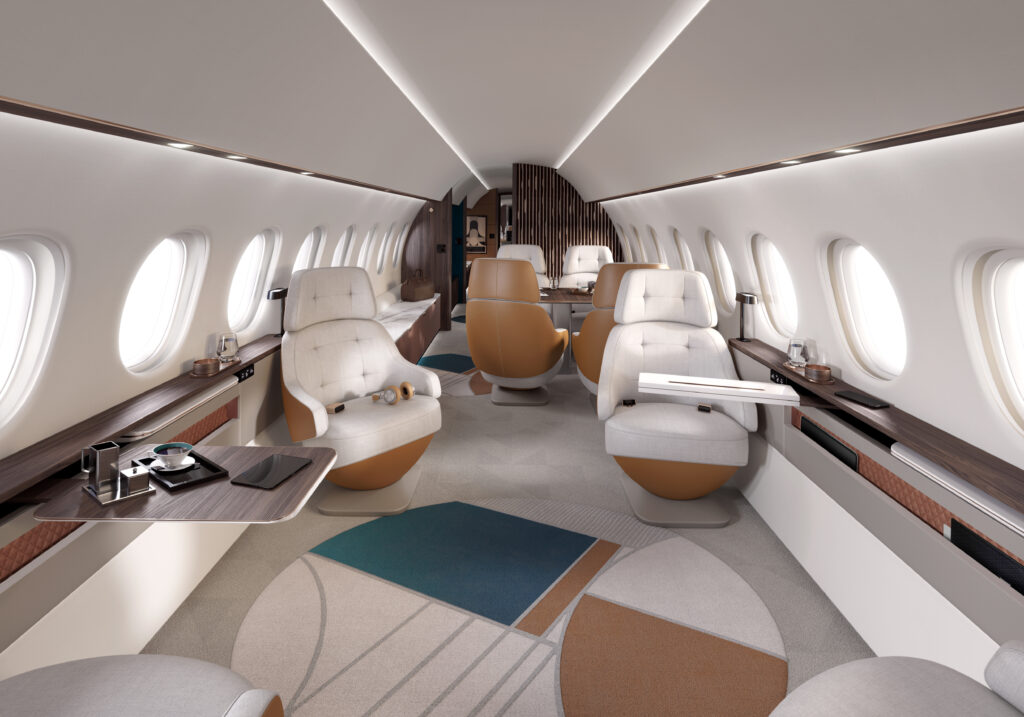On a late Saturday afternoon in early May 1963, Dassault Aviation’s Falcon 20 — originally the Dassault-Breguet Mystère 20 — first took flight from what is still the company’s production headquarters near Bordeaux in southwest France.
The first member of what ultimately became an extensive Falcon family, the Falcon 20 was among the defining aircraft of the emerging industry of business aviation, and over the following sixty years would continue to create and reshape the evolving segments within the market.
Dassault recounts that the test flight ended up taking wing in the afternoon of 4 May 1963 “because of the visit of Charles Lindbergh, who dropped by to inspect the new business jet on behalf of Pan Am. It was only after he had departed Dassault’s Mérignac final assembly plant, near Bordeaux, that the flight team readied the aircraft for flight.”

Charles Lindbergh drops by to inspect the new business jet on behalf of Pan Am. Image: Dassault Aviation
The airline would later order 40 Falcons with an option for 120 more after Lindbergh wired Pan Am’s chief executive officer Juan Trippe with the short message, “I’ve found our bird.”
Pan Am Business Jets would eventually become Dassault Falcon Jet, the Americas subsidiary of the French company headquartered in Teterboro, near New York City.
Over the decades, the Falcon family of jets has evolved substantially. Aircraft launched prior to the 2010s — the Falcon 10, 900 and 7X, among others — are derived from the initial Falcon 20, whether they are the rear-engined twinjets that more closely resemble the original aircraft or the adapted S-ducted tri-jet evolution that started with the Falcon 50 in 1976.
In the ensuing years, Dassault has largely added size, range and mission profile. A pioneer in the use of composite materials, it also introduced glass flight decks, heads-up displays, and continuous improvements in the cabin.
“The formula has not changed,” says Dassault Aviation chief executive officer and chairman Eric Trappier. “Every Dassault aircraft must have superb handling, beautiful lines, and rugged construction. And, of course, it has to provide state-of-the-art comfort.”
Today’s Falcon range includes the twinjet 2000, the tri-jet 7X and 8X.
After a rare misstep in the 2013–2017 time period with the super-midsize Falcon 5X — a large, widebodied long-range rear-engined twinjet that was cancelled because of performance issues with its Safran Silvercrest engines — Dassault pivoted the 5X to a slightly larger and longer version, the 6X.
Unveiled in 2017 with its first flight in 2021, the 6X is scheduled for delivery this year. The even larger Falcon 10X, with its 7500nm range, launched in 2021 and is due to enter service in 2025, powered by Rolls-Royce Pearl engines.
Most Dassault Aviation aircraft are operated as private or business aircraft, although the firm cites some ten percent of Falcon aircraft as “used by military or governmental services”, with “over 200 multirole aircraft used for various missions”.
In addition to the head of state, governmental and senior VIP transport aircraft, Dassault also offers a pair of aircraft in its “Maritime Falcon” family. These jets, the tri-jet Falcon 900MPA and twinjet Falcon 2000MRA, are adapted from the business jet aircraft of the same number.
Additionally, the company also produces the Rafale fighter, Neuron drone, and its Dassault Systèmes software subsidiary produces the widely used CATIA computer-aided design software.
Related Articles:
- Dassault updates on 6X, 10X, new EASy IV flight deck and MRO
- Dassault Falcon 10X cabin is masterclass in French design inspiration
- Bombardier on why the Nuage seat establishes a new comfort paradigm
- Gulfstream’s new Farnborough facility boasts world-class credentials
- Gulfstream G500 cabin to cosset passengers
All images credited to Dassault Aviation
















